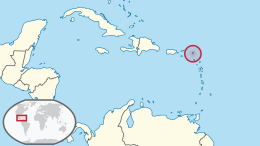Commons:Норми авторського права за територією/Сінт-Мартен
|
Норми авторського права: Сінт-Мартен Скорочення: COM:СІНТ-МАРТЕН | |
 | |
| Терміни охорони авторського права | |
|---|---|
| Стандартні | протягом життя і ще 50 років |
| Для анонімних творів | 50 років з моменту публікації |
| Для аудіовізуальних творів | протягом життя і ще 50 років |
| Для колективних творів | 50 років з моменту публікації |
| Інше | |
| Свобода панорами | For buildings and most 2D and 3D artwork |
| Умови діють до кінця року | так |
| Участь у міжнародних договорах | |
| Відновлення захисту авторських прав згідно з URAA* | 1 січня 1996 року |
| *Робота, як правило, захищена в США, якщо вона є типом творів, що захищені авторським правом у США, опубліковані після 31 грудня 1929 року та захищені в країні походження на дату URAA. | |
This page provides an overview of copyright rules of Sint Maarten relevant to uploading works into Wikimedia Commons. Note that any work originating in Sint Maarten must be in the public domain, or available under a free license, in both Sint Maarten and the United States before it can be uploaded to Wikimedia Commons. If there is any doubt about the copyright status of a work from Sint Maarten, refer to the relevant laws for clarification.
Background
In 1845 all the Dutch Caribbean islands became part of a colony called Curaçao and Dependencies. In 1954 they became the Netherlands Antilles, a constituent country of the Kingdom of the Netherlands. Aruba seceded from the Netherlands Antilles in 1986 to become a separate constituent country. In 2010 the Netherlands Antilles was dissolved. Curaçao and Sint Maarten became autonomous constituent countries within the Kingdom, and Bonaire, Sint Eustatius, and Saba became special municipalities of the Netherlands.
Copyright regulations in Sint Maarten appear to be governed by the Auteursverordening (Author's Regulation) of 1912 as amended by National Decree containing general measures of 12 July 2006 (OJ 2006, no. 58).[1] WIPO holds an English-language unofficial translation of this law.[2]
General
Under the Author's Regulation of 1913 as amended 2006,
- Copyright shall expire 50 years after 1 January of the year following the year of the death of the author.[1913–2006 Art.38(1)]
- The duration of the copyright belonging jointly to two or more persons in their capacity as coauthors of a work shall be calculated from 1 January of the year following the year of the death of the last surviving co-author.[1913–2006 Art.37(2)]
- The copyright in a work of which the author has not been indicated or has not been indicated in such a way that his identity is beyond doubt shall expire 50 years after 1 January of the year following that in which the work was first lawfully communicated to the public.[1913–2006 Art.38(1)]
- The same shall apply to works of which a public institution, association, foundation or company is deemed the author, unless the natural person who created the work is indicated as the author on or in copies of the work which have been communicated to the public.[1913–2006 Art.38(2)]
- If the author discloses his identity prior to the end of the term referred to in paragraph 1, the duration of the copyright in the work concerned shall be calculated in accordance with the provisions of article 37.[1913–2006 Art.38(3)]
- Copyright in works for which the duration of copyright is not calculated in accordance with article 37 and which have not been lawfully communicated to the public within 50 years from their creation shall expire.[1913–2006 Art.39]
- The copyright in a cinematographic work shall expire 50 years after 1 January of the year following the year of death of the last of the following persons to survive: the principal director, the author of the screenplay, the author of the dialogue and the composer of the music created for use in the work.[1913–2006 Art.40]
Not protected
Див. також: Commons:Неохоронювані твори
Under the Author's Regulation of 1913 as amended 2006,
- There is no copyright on laws, decisions and regulations issued by the public authorities, nor on judicial decisions and administrative decisions.[1913–2006 Art.11(1)]
- There is also no copyright on what has been made public by or on behalf of the public authorities, unless that right, either in general by law, decree or regulation, or in a particular case as evidenced by communication on the work itself or when it is made public, reserved.[1913–2006 Art.11(2)]
Freedom of panorama
Див. також: Commons:Свобода панорами
![]() Так for buildings and most 2D and 3D artwork
Так for buildings and most 2D and 3D artwork
![]() Ні for photographs, maps, applied art, industrial design, and models
Ні for photographs, maps, applied art, industrial design, and models
Under the Author's Regulation of 1913 as amended 2006,
- Reproduction or publication of pictures made in order to be put on permanent display in public places, of a work such as is normally found in such places, or of a work relating to architecture, will not be regarded as an infringement of the copyright of the author.[1913–2006 Art.18]
See also
- Curaçao
- Commons:Норми авторського права за територією/Нідерландські Кариби
- Commons:Норми авторського права за територією/Нідерланди
- File:Dutch copyright act 2006-06-22.pdf
Citations
- ↑ Auteursverordening 1913 (in Dutch). Overheid.nl (2006). Retrieved on 2019-03-15.
- ↑ Act of September 23, 1912, containing New Regulation for Copyright (Copyright Act 1912, as amended up to April 1, 2006). WIPO.